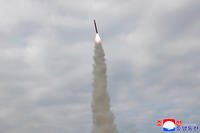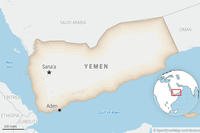In late 2022, a baby born to an active-duty U.S. military family on Guam needed immediate, advanced medical care for a life-threatening pulmonary condition.
With no neonatal intensive care unit, or NICU, on the island that meets U.S. standards, a specialty neonatal team was dispatched from U.S. Naval Hospital Okinawa, Japan, to provide care. The team arrived 24 hours later, but the newborn was too ill to move.
A day later, a second team arrived with more advanced equipment and was able to whisk the baby to Tripler Army Medical Center in Hawaii, where the baby recovered in the facility's advanced NICU.
Read Next: After Deadly Crashes, New 'Leading Theory' on Osprey Issues Points to Sprag Clutches
The newborn was lucky. Earlier that year and again in late 2023, two military dependents weren't as fortunate. One was born three months premature, but even after being stabilized, developed a pulmonary hemorrhage two days after birth when the advanced team arrived and adjusted the baby's breathing tube. The baby couldn't be saved.
A second baby with severe birth defects who died may have had a fighting chance if they had access to an advanced NICU, according to a military physician familiar with all three cases.
Since 2020, however, Guam has not had a neonatal intensive care unit capable of providing U.S. standards of care. U.S. Naval Hospital Guam has a labor and delivery ward but no NICU. A civilian NICU at Guam Memorial Hospital does not meet accreditation standards, and a private hospital on the island, a U.S. territory more than 3,800 miles from Honolulu, closed its NICU before the COVID-19 pandemic.
To meet the needs of severely sick newborns, the Defense Health Agency has established a Neonatal Stabilization Team, or NeoStaT, on Guam to provide care until the babies can be evacuated to a military NICU on Okinawa or Hawaii. The team consists of an active-duty neonatologist who rotates to Guam every six weeks, and two NICU nurses and a NICU respiratory therapist who rotate every 3-6 months.
An active-duty military neonatologist familiar with the setup said the situation raises concerns over the level of care provided to newborns at Naval Hospital Guam, especially as the U.S. military plans to expand its presence on the island in the coming years.
The neonatologist, who requested anonymity to prevent retaliation on the job, said families who transfer to Guam are unaware of the level of care, or lack thereof, at the facility for their infants.
"Even though the incidence is low, the risk is present for every baby born on Guam," the neonatologist told Military.com in emails in January.
From August 2021 to December 2023, 91 babies who were born at U.S. Naval Hospital Guam required higher levels of care. At least 46 were assigned to the NeoSTaT unit, and while most recovered, at least nine were transported off the island and two died, according to data provided by the physician and Defense Health Agency spokesman Peter Graves.
According to Graves, the stabilization team provides around-the-clock coverage and can stabilize a newborn until they improve or can be evacuated off the island via a "neonate capable critical air transport team," or neo-CCATT, overseen by U.S. Transportation Command.
Graves said that while Guam lacks a NICU, the hospital has a "highly skilled team of physicians and nurses who can provide a full spectrum of medical treatment."
"We also have a specially trained team who can provide care for sick newborns until their health improves or they can be transported by the aeromedical evacuation neo-CCATT to another facility that can provide the appropriate level of care," Graves wrote in an email Friday in response to questions sent by Military.com in January.
More than 17,000 active-duty military personnel and family members currently are stationed on Guam, roughly 40% of whom are in their child-bearing years. That number is expected to grow by 2,500 in the next two years. Graves said Naval Hospital Guam delivers an average of 315 babies per year, with that number expected to rise to 487 births by 2033.
U.S. Naval Hospital Guam has four obstetrician/gynecologists, a certified nurse midwife and six family practice physicians who provide maternity services ranging from prenatal care to delivery, Graves said. Three pediatricians provide comprehensive newborn care. A Mother Baby Unit, with 14 registered nurses, 19 corpsmen and an administrative assistant, rounds out that care.
According to Graves, nine billets in the unit are vacant.
Last year, severe staffing shortages at Naval Hospital Okinawa prompted leadership at U.S. military installations on Okinawa to begin drafting plans to have expectant mothers plan to deliver their babies in a Japanese hospital or sign up for a program that would transport them back to the continental U.S. to give birth.
To address the shortfalls, DHA launched a recruiting effort to hire additional providers for Okinawa and pledged to continue full labor and delivery services for all beneficiaries in the U.S. Indo-Pacific Command region.
The issues with military maternal services aren't limited to overseas stations, however. After 2017, when Congress gave the Pentagon broad authority to reevaluate, consolidate and potentially scale back its health facilities, military hospitals began trimming staff and shifting civilian patients to care in the communities surrounding bases.
This led to a military health system that often failed to deliver timely care. In April 2022, providers at Camp Lejeune, North Carolina, reported that staffing shortages were delaying appointments and pushing patients to civilian medical facilities more than an hour away, including a Marine wife who went 12 weeks without a prenatal appointment after moving to Lejeune from Quantico, Virginia.
Naval Hospital Bremerton, Washington, also failed to provide adequate care for beneficiaries, closing its labor and delivery department in a move that negatively affected patients, including a service member who miscarried after spending eight hours in a waiting room at a civilian facility.
The problems with maternity care only were revealed by media investigations or congressional inquiries.
"The Navy likes to be secretive about the shortcomings in the care it provides," the neonatologist said.
Under the direction of Deputy Secretary of Defense Kathleen Hicks, the Defense Health Agency and the services were directed last year to reverse course on their plans to outsource dependent health care by increasing staffing at military health facilities and bringing patients back into military health care facilities for their medical care.
As part of that effort, the DoD issued a $43 billion contract in May to 11 companies to provide civilian contract physicians, dentists, nurses and medical support services in military treatment facilities in the U.S., Puerto Rico and Guam.
But those plans don't appear to include building a NICU on Guam. The neonatologist said that doctors at Indo-Pacific Command thought the Defense Health Agency was working with the Navy toward building a NICU or creating a program that would transfer expecting mothers off the island to deliver their babies.
But in his email, Graves said there have been "no thoughts about standing up a NICU at U.S. Naval Hospital Guam."
"Rather than standing up a NICU at U.S. Naval Hospital Guam, Naval Medical Forces Pacific and U.S. Naval Hospital Guam leadership made the decision to implement a Neonatal Stabilization Team comprised of a rotating team of providers temporarily assigned to U.S. Naval Hospital Guam," Graves wrote.
In addition to facing staffing shortages of civilian providers, the military services also struggle to retain uniformed medical providers. According to the neonatologist, closures of facilities such as a small NICU at Langley Air Force Base in Virginia have left only Germany, Okinawa and San Antonio, Texas, as potential duty stations for Air Force NICU nurses.
"It's created a 'death by a thousand paper cuts' scenario for areas like [obstetrics, pediatrics, NICU]," the neonatologist wrote.
The Defense Department's fiscal 2025 budget calls for $40.3 billion for the Defense Health System, not counting construction or military personnel salaries. The proposed House appropriation for fiscal 2025 increases the funding by more than $800 million, in part over the chronic staffing shortages and the inability of military health providers to maintain their skills.
Whether the funding will benefit U.S. Naval Hospital Guam remains to be seen. According to the neonatologist, a NICU, regardless of size, should be a priority. Military families, according to the neonatologist, need to know that they won't have access to one if they accept an assignment to the island.
"There has been some disclosure about the NeoSTaT but not in a way that is clear to families the true potential risk to their babies," the neonatologist wrote.
Related: Denied Care, Deaths in Japan Result from Lack of Emergency Medical Services for American Personnel














